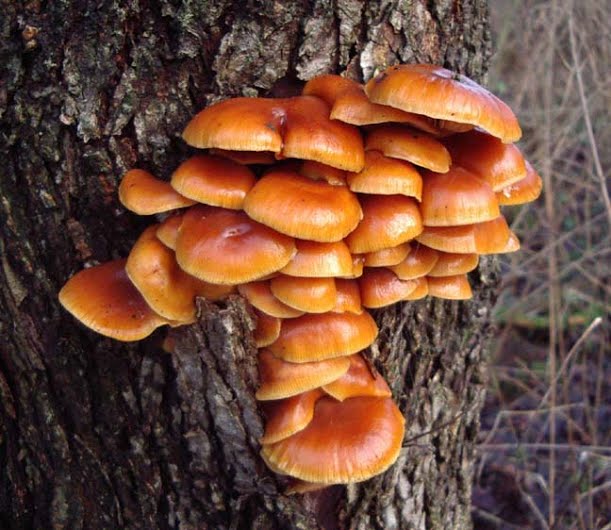 |
| Flammulina velutipes is example of Basiodiomycetes |
The Basidiomycetes constitute the largest of the three classes of the Basidiomycota (basidiosporic fungi), a very large class of about fourteen thousand species of the most diverse terrestrial fungi.
The largest fungi belong in the Basidiomycetes class, as do some of the most unusual. All members of Basidiomycetes produce a basidium from hyphal cells and not from spores. (The basidiumis a cell produced at the end of a dikaryotic hypha.)
The basidium will produce either two or four spores as the result of meiosis. The basidium may be either a nonseptate cell, with two or four sterigmata (the basidiospore is produced on the end of the sterigma) at the apex, or it may be septate.
  |
The septa can be either horizontal or vertical. When observed from the apex, the vertical septa will produce a crosslike pattern. In either case, septate basidia will have one sterigma per cell. Basidiospores are thin-walled and may be released either actively or passively.
Basidiocarps
The basidiocarp is the fruiting body of the fungus. The fungus grows as a dikaryotic mycelium through the substrate. When the fungus has acquired sufficient energy, and environmental conditions are adequate, the fungus will produce a basidiocarp. The basidiocarp often appears overnight and may reach a meter in height.
Some basidiocarps are tiny, less than a centimeter in height. The basidiocarpmay look like a mushroom or may have the appearance of a golf ball or any variation in between. The basidiocarp may be edible or deadly poisonous. It often serves as food for wild animals and insects.
Classification
The Basidiomycetes are divided into two groups based on septa in the sterigma. Those that have a septate sterigma are classified in Phragmobasidiomycetidae, while those without septa in the sterigma are classified in Holobasidiomycetidae. Phragmobasidiomycetidae is a small group that includes some smaller fungi whose basidiocarps often have a gelatinous appearance.
Holobasidiomycetidae is a large group of fungi and is easily divided into two major groups based on the release of the basidiospore. The hymenomycetes release spores actively, while the gasteromycetes release spores passively.
Hymenomycetes
 |
| hymenomycetes |
The hymenomycetes are the most familiar fleshy fungi. These are the ones that resemble the common mushroom and can be seen when the weather is warm and damp. These fungi may have gills or pores on the underside of the pileus (the cap).
The gills or pores are lined with a layer of basidia that produce spores. Some of these fungi are produced on the sides of trees or fallen wood and may be a centric. Many of them appear to arise from the ground. Colors of these fungi can be found anywhere in the rainbow, but most appear in earth tones.
Some of the major orders within the hymenomycetes are the Agaricales and the Boletales. The Agaricales contain the fungi that produce gills on the underside of the pileus. The Boletales contains the fungi that produce pores on the underside of the pileus.
For the most part, the Agaricales are fleshy fungi that are supple at maturity and last for no more than a week or two in nature. The Boletales are also fleshy and can be confused with other fungi that have pores and are hard. Some of these hard fungi are common parasites of trees; the "shelves" that they produce can grow for years.
Gasteromycetes
 |
| gasteromycetes |
The gasteromycetes are a much more diverse group of fungi. The fungi in this group are often associated with soil or decomposing organic matter, although some may be mycorrhizal (in a symbiotic association with plant roots). There is tremendous diversity in this group, and many scientists believe that this group is artificial (not based on evolutionary relationships).
Some of themore interesting fungi of this group are shaped like balls that lie on the soil. Members of Lycoperdales and Sclerodermatales produce ball-like basidiocarps that form at the soil line. The size can range from that of a small marble up to that of a soccer ball.
These are called puffballs, as they release spores in small clouds when kicked. In nature, the upper layers of the basidiocarp crack, and spores are released as drops of water, hitting the outer layer of the basidiocarp. Many of these are edible when properly identified.
Other interesting fungi are found in the order Nidulariales. These are called the bird's nest fungi, as the basidiocarp resembles a small bowl containing two or three small "eggs", which contain the basidia. When a droplet of water lands in the "nest" the "eggs" are thrown upward and outward.
 |
| stinkhorns |
As they are released, a small thread is pulled behind, and the thread sticks onto some part of a plant, such as a blade of grass. The "egg" will then degrade and release the spores to be disseminated in the wind.
Among the most bizarre fungi are the stinkhorns. These fungi produce basidiocarps from structures that look like chicken eggs. The elongate structure produces the basidia on the end in a mass of slimy, smelly mucus. Flies are attracted to the smell, land on the mucus, and fly away. The basidiospores adhere to their feet and drop off, thereby disseminating the fungus.